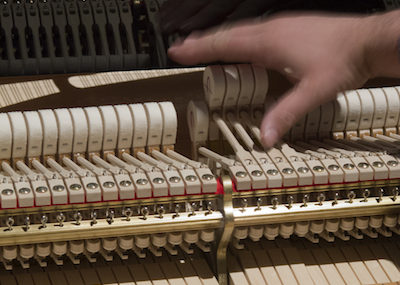The piano requires various forms of maintenance throughout its life for it to produce the best sound possible.
Tuning
Tuning isn’t something where there is a standard for every piano. A new piano may need several tunings a year to keep it properly balanced. A piano that has been well cared for and in a stationary position in the home may need tuning once or twice per year. A concert piano that is played by professionals on a daily basis made need a regular tuning every few weeks. Some professionals prefer to have their piano tuned before every major event. 
When a piano is only slightly out of tune, it loses the tonal quality characteristics of a recently tuned piano, especially in the middle and upper ranges of sound. Even a slight out of tune sound can be unpleasant to the listener. It can even deter a budding pianist from continuing with lessons because it doesn’t sound quite right.
Voicing
The felt on the hammers of the piano tend to harden over time. The felt becomes depressed by repeated impact as keys are struck. They also form grooves and wear marks as they connect with the strings. While hammers are used to produce a bright tonal quality, these wear marks can change the sound being produced to something harsh and undesirable.
Piano technicians use special tools to soften the hammers. They can also use hardening agents if the hammers soften up. Since the hammers are not used with equal frequency, they tend to wear in uneven increments. How much change is required to each hammer is dependent on both the piano’s settings and on the preferences of the player.
Regulation
Over time, the performance of the piano action declines. The wood may warp. The tension may falter. The sound declines. The goal of regulation is to make the piano’s sound consistent across all notes. It makes the keys movements more subtle to the motions of the player.
There are dozens of adjustments a piano will go through when being regulated. The most important include:
- Key weight – to regulate the action mechanism of the key springs
- Repetition springs – which allows the hammer to repeatedly strike with minimal lifting of a key
- Drop – how far the hammers fall back when let off
- Let off – the point when the hammer disengages from the jack
Restoration
After a lifetime of use, usually measured by decades, pianos may need complete restoration to keep its sound healthy and functioning. If well taken care of, the frame and some parts of the action may remain in good condition. Piano restoration experts try to maintain originality whenever possible, rebuilding or maintaining as much as they can as possible. Restoration is labor intensive, and therefore can be time intensive and quite expensive as well.


